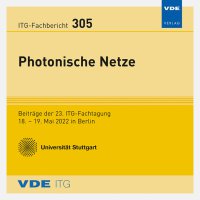Introducing γ-lifting for Learning Nonlinear Pulse Shaping in Coherent Optical Communication
Conference: Photonische Netze - 23. ITG-Fachtagung
05/18/2022 - 05/19/2022 at Berlin
Proceedings: ITG-Fb. 305: Photonische Netze
Pages: 8Language: englishTyp: PDF
Authors:
Uhlemann, Tim; Span, Alexander; Doerner, Sebastian; ten Brink, Stephan (University of Stuttgart, Germany)
Abstract:
Pulse shaping for coherent optical fiber communication has been an active area of research for the past decade. Most of the early schemes are based on classic Nyquist pulse shaping that was originally intended for linear channels. The best known classic scheme, the split digital back propagation, uses joint predistortion and post-equalization and hence, a nonlinear transmitter; it, however, suffers from spectral broadening on the fiber due to the Kerr-effect. With the advent of deep learning in communications, it has been realized that an “autoencoder” can learn to communicate efficiently over the optical fiber channel, jointly optimizing geometric constellations and pulse shaping – while also taking into account linear and nonlinear impairments such as chromatic dispersion and Kerr-nonlinearity. E.g., shows how an autoencoder can learn to mitigate spectral broadening due to the Kerr-effect using a trainable linear transmitter. In this paper, we extend this linear architectural template to a scalable nonlinear pulse shaping consisting of a convolutional neural network at both transmitter and receiver. By introducing a novel γ-lifting training procedure tailored to the nonlinear optical fiber channel, we achieve stable autoencoder convergence to pulse shapes reaching information rates outperforming the classic split digital back propagation reference at high input powers.


